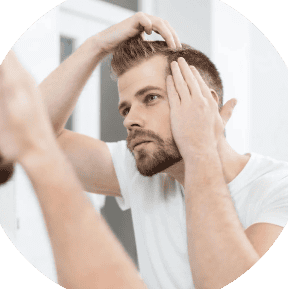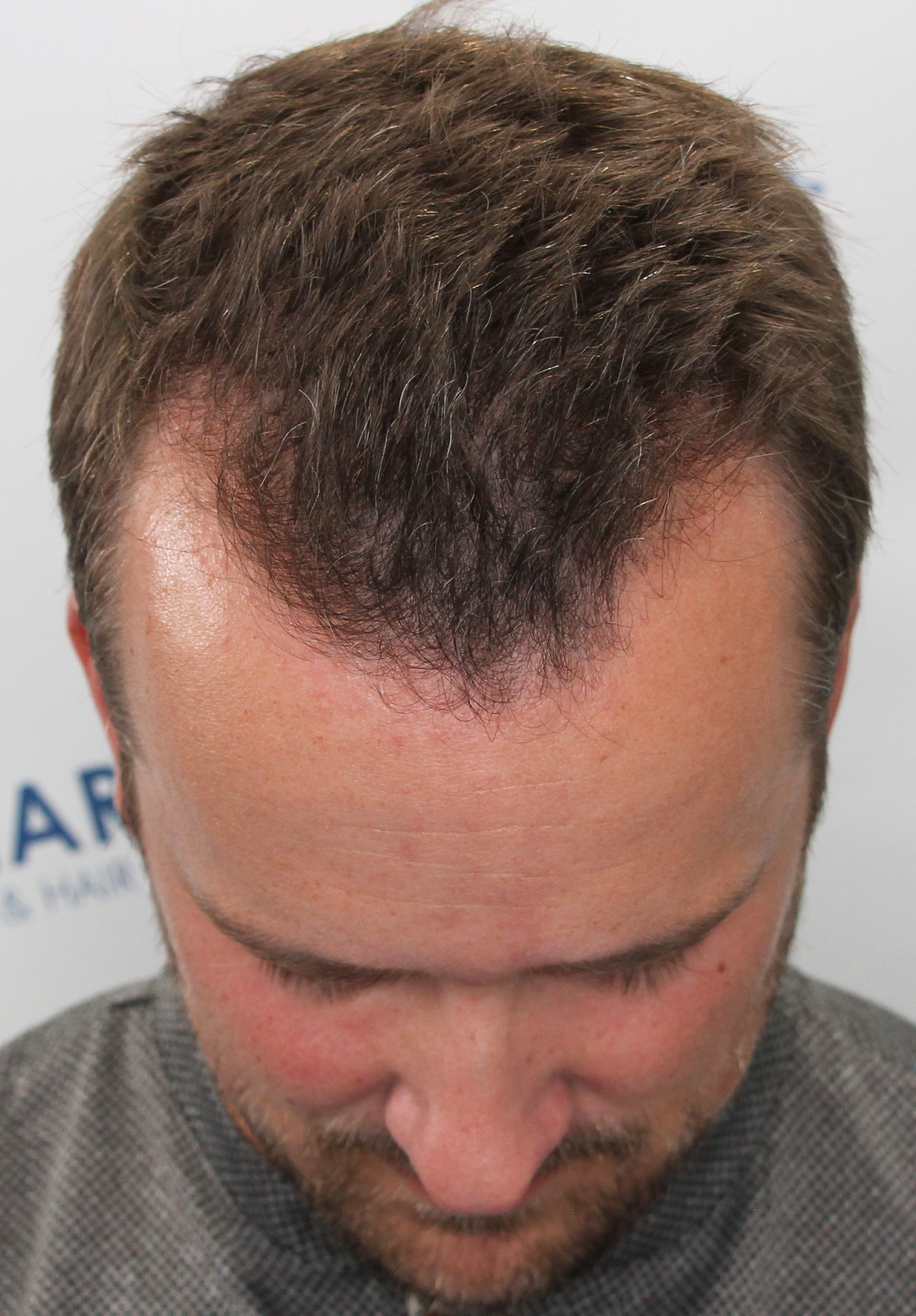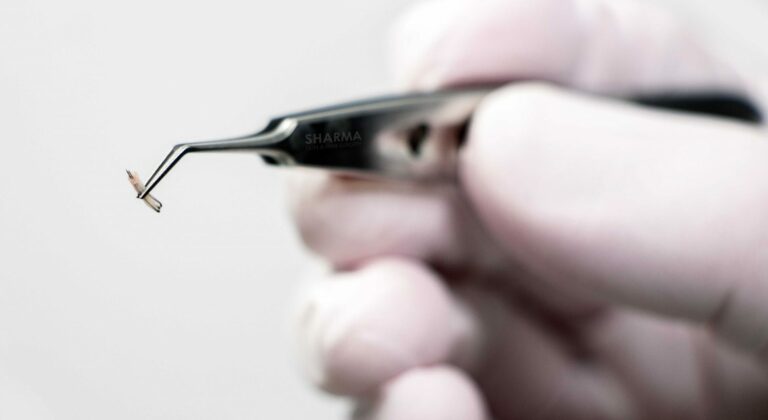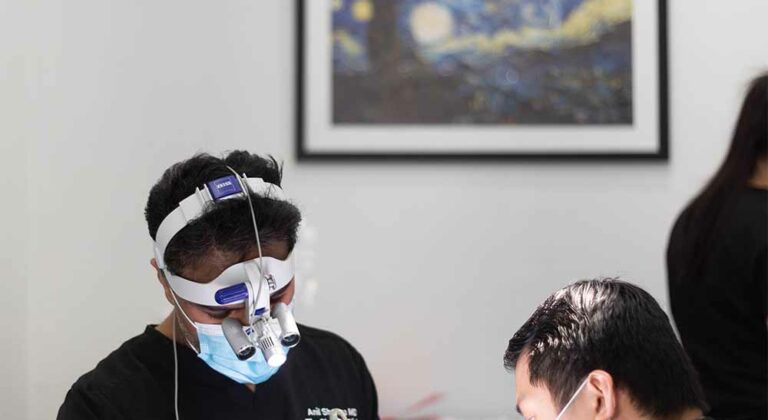Around 85% of men start to experience a receding hairline by age 50, and for many, the signs of hair loss can begin well before then — often in their late 20s or early 30s. Despite how common it is, hair loss is still a sensitive topic, leaving a lot of men feeling frustrated and powerless as they watch their hairline recede.
The good news is that if you tackle hair loss early, you can often achieve much better results. Today’s treatments are not only great at stopping hair loss in its tracks but can also help regrow hair that’s already been lost. Even if you’ve already noticed thinning, there are effective solutions that can make a real difference. Let’s explore how to identify a receding hairline and the options available to reverse it.
What is a receding hairline?
A receding hairline is when the hair at the front of your head starts to move back, making your forehead appear larger over time. It’s common in men and often begins with thinning at the temples, creating an “M” or “V” shape. While it’s usually associated with aging, some people start to notice their hairline receding as early as their late 20s or 30s.
Spotting a receding hairline is usually quite simple. If you’re seeing your hairline gradually moving back from the front of your forehead, it’s likely a receding hairline. This is different from a mature hairline, which is just a normal part of getting older.
The main ways to tell them apart are the speed and pattern of hair loss. A receding hairline tends to happen more quickly and often follows a clear pattern, while a mature hairline shifts more slowly and subtly. If you’re noticing these changes, it might be time to consider some options for managing it.
Discuss your receding hairline with Dr SharmaWhat causes a receding hairline?
There are several reasons behind this common issue, ranging from hormones to genetics:
Male pattern baldness (Androgenetic Alopecia)
Male pattern baldness, or Androgenetic Alopecia, is the most common reason people experience a receding hairline. This condition usually comes down to a mix of age, genetics, and hormones. The hormone Dihydrotestosterone (DHT) is a key player here. It attaches to hair follicles, causing them to shrink over time. As a result, these follicles eventually stop producing hair, leading to the familiar pattern of thinning and hair loss.
Frontal Fibrosing Alopecia
Frontal Fibrosing Alopecia is a condition that mainly affects postmenopausal women, though it can occur in others as well. It leads to hair loss on the scalp and thinning of the eyebrows. While menopause is a significant factor, other potential causes include stress, poor nutrition, certain medications, and harsh hair treatments. The exact cause of frontal fibrosing alopecia isn’t fully understood, but addressing these contributing factors might help manage the condition.
Age
Let’s face it — age is a big one when it comes to hair loss. The older we get, the longer our hair follicles are exposed to DHT, which causes gradual damage over time. As a result, hair follicles begin to weaken and eventually stop producing hair altogether. Interestingly, the follicles at the front of the scalp are usually the first to be affected, which is why many people notice their hair thinning in this area first.
Gender
While hair loss is often talked about in the context of men, women experience it too. Female pattern hair loss is a common issue for many women, and the good news is that treatments for women can be just as effective as those for men. So if you’re a woman dealing with hair loss, don’t lose hope — there are options that can help.
Genetics
Genetics play a major role in whether you’ll experience hair loss. Take a moment to consider your family history — especially the hair of your male relatives. If they have full heads of hair and it’s not thanks to treatments like hair transplants or medications such as finasteride or minoxidil, you might have a better chance of keeping your hair without medical intervention. Unfortunately, we can’t change our genes, but knowing your family’s hair history can give you some insight into your own risk.
Hormones
Hormonal changes, particularly higher levels of androgenic hormones, can make you more likely to develop a receding hairline. These hormones affect hair follicle health and can speed up hair loss in people who are already predisposed.
Ethnicity
It’s interesting to note that the likelihood of male pattern baldness varies by ethnicity. Caucasians and Africans are more commonly affected compared to Asians and Native Americans. While the exact reasons for these differences aren’t fully understood, they highlight how complex the factors influencing hair loss can be.
What are the stages of a receding hairline?
A receding hairline usually goes through several stages, and one of the most common ways to describe these stages is with the Norwood scale. This scale is widely used to classify male pattern baldness. Here’s a quick overview of the stages:
| Stage 1: No hair loss | At this stage, everything looks normal. There’s no noticeable change in your hairline — just the way it always has been. |
| Stage 2: Early receding hairline | You might start to notice a slight recession at the temples. It creates a subtle M-shape or a little widow’s peak. Most people don’t even notice this change right away, but you might feel it. |
| Stage 3: Moderate recession | This is when the changes become more obvious. The hairline recedes further, and the M-shape becomes more pronounced. It’s noticeable, and if you look in the mirror, you can see the difference clearly. |
| Stage 4: Moderate recession with crown thinning | Along with the hairline retreating, you’ll also see thinning at the crown of your head. It’s a double whammy, with both the front and top showing signs of hair loss. |
| Stage 5: Advanced recession and crown thinning | The hairline continues to move back, and the thinning at the crown becomes more significant. The bald spots at the front and the crown start to merge, creating a more distinct pattern of hair loss. |
| Stage 6: Advanced baldness | At this point, the recession is noticeable, and the thinning areas are starting to connect. You’ll see a significant bald spot at the top of your head, with just a narrow band of hair remaining around the sides and back. |
| Stage 7: Extensive balding | The top of your head is mostly bald now, with only a thin strip of hair left on the sides and back. It’s a big change, and you can really see how much hair has been lost. |
| Stage 8: Severe baldness | This is the most advanced stage. Almost all the hair on top is gone, and you’re left with just a narrow band of hair around the sides and back. It’s a clear sign of severe hair loss. |
6 signs that a hairline is receding
Noticing changes in your hairline can be a bit unsettling, but identifying early signs can help you take action sooner. Here’s a rundown of what to look out for if you’re worried about your hairline.
1. M-shaped pattern
If your hairline starts to recede more at the temples than in the middle, you might notice an M shape forming. Sometimes it can even look a bit like a mohawk.
How to check: Draw around your hairline with a washable marker to see if it creates an M shape. Snap a photo and keep an eye on it over time. If the M becomes more pronounced, it could be a sign that your hairline is receding, and it might be time to consider your options.
2. Higher hairline
A higher hairline means your hairline is moving back, making your forehead look larger than it used to.
How to check: Measure the distance between your hairline and your eyebrows with a ruler. If this distance seems to be increasing, it might be a sign that your hairline is receding.
3. Uneven hairline
When parts of your hairline recede faster than others, you end up with an uneven or jagged look.
How to check: Use a ruler to see if your hairline is even with your brow line. If it’s not, you might be dealing with an uneven hairline, which is another form of recession.
4. Increased hair shedding
Losing some hair every day is normal, but if you notice a lot more hair shedding, it could be a red flag. This might be due to stress, illness, or male pattern baldness.
How to check: Collect and count the hairs you shed during a shower or after brushing. If you’re losing more than 50-100 hairs a day, it might be worth looking into.
5. Thinning hair
Thinning hair means each strand becomes finer and weaker.
How to check: Compare the thickness of hair from the back of your head to those at your hairline. If the hair at your hairline seems thinner, it could be a sign that your hairline is receding.
6. Visible scalp
Sometimes, before you notice your hairline receding, you might just see more of your scalp.
How to check: Stand under a strong light and see if your scalp is more visible through your hair. If you can see more of your scalp than before, it could be an early sign of hair loss.
To get a good handle on your hair loss, it’s helpful to keep track over the next four to twelve months. Try taking a photo once a month with your hair pulled back — using a hairband or some gel can make it easier. Keep your head in the same position each time, and try to use the same camera angle, lighting, and mirror for consistency. It might be tough to see changes from month to month, but comparing photos from the start to a few months in can make differences more noticeable.
Treatments for a receding hairline
If you’re dealing with a receding hairline and looking for ways to address it, there are several options you can explore. Whether you prefer non-surgical solutions or are open to medical procedures, there’s something out there that might suit your needs.
Non-surgical treatments
If you’re dealing with a receding hairline and want to explore non-surgical options, you’re in luck — there are quite a few medications and non-surgical treatments available:
Finasteride
This medication is usually taken daily in pill form. It works by lowering the levels of DHT that can attach to hair follicles, helping to stop hair loss in about 70% of users and even regrow lost hair in nearly 40% of cases.
There are some rare but important side effects to consider, including the controversial issue of post-finasteride syndrome (PFS). While there’s no solid scientific proof that PFS exists, and if it does, it’s very rare, it’s a good idea to educate yourself about the potential risks. Also, finasteride is not for women. If you prefer, finasteride is available as a topical ointment too, and some studies suggest this form might be even more effective for regrowing hair with fewer side effects.
Minoxidil
Most research on minoxidil has focused on treating hair loss at the crown of the head, but it can also be effective for the hairline. At the Sharma Clinic, we’ve seen many patients have success using minoxidil on their hairline.
It comes as a topical solution in either a foam (which tends to work better) or a liquid form. Minoxidil is suitable for both men and women — men typically use a 5% solution while women use a 2% solution. The most popular brand is Rogaine, but generic options like Hims offer the same formula at a lower price and can be just as effective.
Steroid creams
Steroid creams can be effective for treating hair loss, especially when inflammation is involved, like in Frontal Fibrosing Alopecia. These creams work by reducing inflammation on the scalp, which can help slow down or stop hair loss. You apply them directly to the affected areas, and they’re usually quite effective when used properly under the guidance of a healthcare provider.
Derma rolling
Derma rolling, or microneedling, is a technique that uses a roller with tiny needles to create small punctures in the scalp. This can boost hair growth by stimulating the follicles and improving the absorption of topical treatments like Minoxidil or topical finasteride.
It’s relatively easy to do at home — just roll the device gently over your scalp in different directions. Make sure to follow good hygiene practices to prevent any irritation or infection. It’s a handy method to enhance the effectiveness of other treatments.
Learn about topical Finasteride microneedlingRosemary oil
Even though it’s a natural remedy, rosemary oil might be a useful treatment for hair loss. Some early studies suggest that it can improve blood flow to the scalp and reduce inflammation, which could help stimulate hair growth. You just need to apply a few drops to the thinning areas and massage it in. It’s a simple and low-risk option that you might want to try as part of your hair care routine, though more research is needed to confirm its effectiveness.
Medical procedures
If you’re considering more advanced options for treating a receding hairline, medical procedures might be the next step. These treatments can offer more dramatic and long-lasting results compared to non-surgical methods. Here’s a closer look at some popular medical procedures for hair restoration.
Hair transplant
Hair transplants are often the most effective solution for hair loss, although they can be more invasive compared to other options. Despite this, the procedure is relatively pain-free, typically performed on an outpatient basis, and most patients can return to a normal-looking appearance the very next day. Full resumption of regular activities generally occurs within 2-3 weeks for most people.
Hair transplants are usually categorized into two types, both of which are considered permanent solutions to hair loss.
- FUE: During this procedure, the surgeon makes hundreds of tiny incisions in the scalp’s areas of hair loss (the “recipient” area). They then extract individual hair follicles from the back and/or sides of the head (the “donor” area). These follicles are carefully implanted into the incisions in the recipient area.
- FUT: This technique is similar to FUE but involves removing a long, thin strip of skin from the donor area. The hair follicles are extracted from this strip and then transplanted into the recipient area’s incisions. While FUT is highly effective, it may leave a thin scar on the back of the head.
When performed correctly on suitable candidates, the success rate for FUE and FUT hair transplants is an impressive 97-99%.
Find out more about hair transplantsScalp reduction surgery
Scalp reduction is a surgical procedure designed to address bald or thinning areas of the scalp. In this procedure, the surgeon removes a portion of the bald skin and then pulls the remaining skin together, stitching it in place. This effectively reduces the area that needs to be covered with hair.
Typically, the surgery is done under local anesthesia, meaning you’ll be awake but won’t feel any pain during the procedure. The surgeon makes incisions in the scalp to excise the bald areas, then pulls the scalp taut before stitching it closed. In some cases, a tissue expander may be used beforehand to stretch the skin, making the procedure easier.
After the surgery, it’s normal to experience some swelling, bruising, and discomfort. Recovery times can vary from person to person, but most people can get back to their usual activities within a few weeks. Overall, scalp reduction can be an effective option for those looking to improve their hair coverage.
Platelet-Rich Plasma (PRP) Therapy
Platelet-Rich Plasma (PRP) Therapy is a treatment for hair thinning and loss that starts with drawing a small amount of your blood. This blood is then processed to concentrate the platelets, which are rich in growth factors. The concentrated PRP is injected into your scalp where you’re experiencing thinning or hair loss.
The procedure involves drawing blood and spinning it in a centrifuge to separate the platelets from other components. After this, the PRP is injected into the scalp in the areas where you’re seeing hair loss.
Typically, you’ll need several sessions over a few months, with maintenance treatments every few months to keep up the results. One of the big advantages of PRP therapy is that it uses your own blood, so the risk of an allergic reaction is minimal. The growth factors in the platelets can help stimulate your hair follicles and improve hair density. Plus, since it’s a non-surgical procedure, there are no cuts or stitches involved.
As for how well it works? Results can vary. Some people see a noticeable improvement in hair density and thickness, while others might see only slight changes. It tends to be more effective if you’re dealing with early-stage hair loss.
Low-Level Laser Therapy (LLLT)
Low-Level Laser Therapy (LLLT) is a treatment aimed at boosting hair growth. It works by using low-level lasers or light-emitting diodes (LEDs) to stimulate hair follicles. The light helps to increase blood flow, cell metabolism, and collagen production in the scalp, which can encourage hair growth.
Typically, LLLT involves using a device like a helmet, cap, or comb that’s equipped with lasers or LEDs. Each session usually lasts between 20 and 30 minutes, and you’ll need to use the device several times a week.
There are different types of devices for LLLT. Laser combs are handheld and focus on smaller areas, while laser helmets or caps cover a larger part of your scalp. Laser bands are headbands with lasers built in, designed for specific wear times.
Studies suggest that LLLT can be effective in stimulating hair growth and improving hair density, especially for people with androgenetic alopecia (pattern baldness). For the best results, it’s important to be consistent with your treatments. Many people start to see noticeable changes after a few months of regular use.
Can a receding hairline grow back without treatment?
It really depends on what’s causing your hair loss. If it’s due to stress, illness, or medication, your hair might start to grow back on its own once the underlying issue is resolved. For example, if a particular medication is causing hair loss, stopping that medication might lead to regrowth.
Still, it’s a good idea to see a hair loss specialist. They can keep an eye on your situation and offer personalized advice. If your hair loss is due to conditions like male pattern baldness or frontal fibrosing alopecia, though, you’ll likely need some medical treatment to see significant regrowth.
Hair loss prevention and corrective tips
Keeping your hair healthy and minimizing hair loss often comes down to a few simple lifestyle changes and habits. Here are some practical tips to help you maintain a full head of hair:
Reduce stress
Stress can play a big role in hair loss, so finding ways to manage it is key. Try to incorporate stress-relief practices into your routine, like deep breathing, meditation, or even just regular exercise. Activities that you enjoy and that help you unwind can also make a difference.
Eat a healthy diet
A well-balanced diet can do wonders for your hair. Aim for a mix of fruits, veggies, lean proteins, and whole grains. Nutrients like iron, zinc, and vitamins A, C, D, and E are particularly good for hair health. And don’t forget to drink plenty of water — it’s important for overall health and helps keep your hair hydrated too.
Choose gentle hair products
Many hair products are packed with harsh chemicals that can damage your hair. Look for shampoos, conditioners, and styling products that are free from sulfates, parabens, and artificial fragrances. Opting for gentler, more natural products can help keep your hair and scalp in better shape.
Avoid tight hairstyles
Tight hairstyles like buns, braids and ponytails can pull on your hair and cause damage. Whenever possible, go for looser styles and avoid pulling your hair back too tightly. If you use hair ties, choose ones that are gentle and won’t snag or break your hair.
Read more: Haircuts after a hair transplant
Struggling with hair loss? Find effective treatments at the Sharma Clinic
Hair loss is a common issue affecting both men and women, typically starting after the age of 20. It doesn’t have to be a taboo subject, and fortunately, it is often treatable. While hair loss can be managed even in its advanced stages, detecting the early signs and beginning treatment promptly gives you the best chance for a successful outcome.
At the Sharma Clinic, we have years of experience treating hair loss in both men and women. We will diagnose the underlying cause and create a tailored treatment plan for you. Our top-tier surgeons excel in both FUE and FUT hair transplants, and we also offer effective treatments such as Minoxidil and finasteride to help slow or even reverse hair loss.
BOOK NOW
Talk to a Hair Transplant Expert
Are you looking for the most effective treatment plan to reverse the effects of hair loss? Dr. Sharma has a long-lasting commitment to offering the best services in the industry. Not only is he experienced with hair loss treatment, but he is passionate about helping each patient receive excellent results.

SOURCES
- https://www.ncbi.nlm.nih.gov/pmc/articles/PMC4989388/
- https://plasticsurgerykey.com/phenotype-of-normal-hairline-maturation/
- https://my.clevelandclinic.org/health/diseases/23316-frontal-fibrosing-alopecia
- https://www.ncbi.nlm.nih.gov/books/NBK278957/
- https://pubmed.ncbi.nlm.nih.gov/10365924/
- https://pubmed.ncbi.nlm.nih.gov/9777765/
- https://www.ncbi.nlm.nih.gov/pmc/articles/PMC7649170/
- https://www.ncbi.nlm.nih.gov/pmc/articles/PMC4809380/
- https://www.ncbi.nlm.nih.gov/pmc/articles/PMC3746236/
- https://pubmed.ncbi.nlm.nih.gov/32033719/
- https://www.ncbi.nlm.nih.gov/pmc/articles/PMC10186041/
Share this:
Medically reviewed by
Updated on
Have a question?
Find out how we can help you look feel your absolute best
Contact us 780-476-7970


